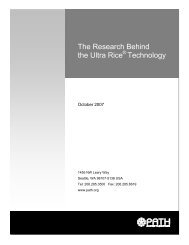Nepal Clean Home Delivery Kit: Evaluation of the Health Impact - Path
Nepal Clean Home Delivery Kit: Evaluation of the Health Impact - Path
Nepal Clean Home Delivery Kit: Evaluation of the Health Impact - Path
Create successful ePaper yourself
Turn your PDF publications into a flip-book with our unique Google optimized e-Paper software.
I. INTRODUCTION<br />
Tetanus and sepsis are among <strong>the</strong> leading causes <strong>of</strong> maternal and neonatal death and<br />
illness in developing countries. These infections occur mainly as a result <strong>of</strong> contamination<br />
from an unclean environment and from harmful delivery practices, including <strong>the</strong> use <strong>of</strong><br />
unclean materials during <strong>the</strong> delivery. Both mo<strong>the</strong>r and baby are exposed to <strong>the</strong> risk <strong>of</strong><br />
infection. The high rate <strong>of</strong> home deliveries, <strong>of</strong> births attended by people with little or no<br />
training in hygienic delivery practices, and <strong>of</strong> shortages <strong>of</strong> suitable clean implements and<br />
materials all contribute to <strong>the</strong> problem <strong>of</strong> perinatal infection. To address <strong>the</strong>se problems, a<br />
clean home delivery kit (CHDK) was developed (with technical assistance from PATH<br />
and Save <strong>the</strong> Children U.S. and funding from USAID, UNICEF, and UNFPA) and has<br />
been produced by MCH Products Pvt., Ltd. and sold in <strong>Nepal</strong> since 1994. A needs<br />
assessment was carried out to identify important components, appropriate configuration<br />
and packaging, priority messages for <strong>the</strong> pictorial insert, and an acceptable price.<br />
Prototype kits were evaluated in a field trial involving 131 births, and <strong>the</strong>n test marketing<br />
was carried out in two districts, during which more than 2,000 kits were sold. Since that<br />
time, <strong>the</strong> kit has been marketed and promoted throughout <strong>Nepal</strong>.<br />
With more than three years <strong>of</strong> experience distributing kits and more than 300,000 kits<br />
sold, it is important to evaluate <strong>the</strong> impact clean delivery kits can have on <strong>the</strong><br />
well-being <strong>of</strong> mo<strong>the</strong>rs and newborns. While WHO (1998) and o<strong>the</strong>rs recommend<br />
provision <strong>of</strong> disposable delivery kits to women and community birth attendants, it is<br />
recognized that it will be difficult to prove that <strong>the</strong>y have a beneficial impact independent<br />
<strong>of</strong> o<strong>the</strong>r interventions (Smith and Fortney, 1996). This study was intended to evaluate<br />
short-term health impacts and intermediate outcomes such as changes in knowledge or<br />
behavior that can reasonably be expected to have a beneficial impact on health in <strong>the</strong> long<br />
term. The study was funded by <strong>the</strong> <strong>Health</strong>Tech Technologies for <strong>Health</strong> project (a<br />
cooperative agreement between PATH and USAID), with technical assistance from<br />
PATH and administrative and financial support from Save <strong>the</strong> Children U.S.<br />
II. STUDY QUESTIONS<br />
Immediate <strong>Health</strong> <strong>Impact</strong><br />
Since <strong>the</strong> kit is primarily designed to reduce <strong>the</strong> risk <strong>of</strong> infection by providing a clean<br />
delivery surface, clean cutting instrument and ties for <strong>the</strong> cord, and clean hands for <strong>the</strong><br />
attendant, <strong>the</strong> main health benefit to be expected is a reduction in maternal and newborn<br />
infection rates, particularly cord infection. Although maternal tetanus and puerperal<br />
infection are serious problems, <strong>the</strong>y are sufficiently uncommon that it would be difficult<br />
to detect a change in <strong>the</strong>ir rates without a massive study and very large sample size.<br />
Similarly, it would require observation <strong>of</strong> several thousand newborns to be able to detect<br />
a change in <strong>the</strong> neonatal tetanus rate. Therefore, <strong>the</strong> study focused on simple cord<br />
infection, a more common illness, as a precursor to more serious infections (Garner et al,<br />
1994) and an indicator <strong>of</strong> potential exposure to tetanus.<br />
<strong>Nepal</strong> <strong>Delivery</strong> <strong>Kit</strong> <strong>Evaluation</strong> May 2000 4
















